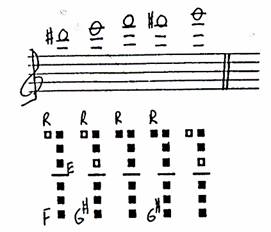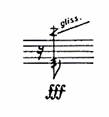| The Clarinet of the Twenty-First Century - E. Michael Richards |
CHAPTER 4 - Other Resources
Teeth on Reed
Portamento is also possible by moving the teeth lightly on the reed from about midway down to further away (towards the shoulder) from the tip. However, the portamento will not always be smooth; jumps in partials are unavoidable, much like portamento harmonics on the contrabass (sounds that are reminiscent of seagulls). These sounds, which can not really be infallibly controlled according to pitch, tend to range from D-sharp 6 upwards (depending on qualities of the reed). The result will be a thin, high-pitched whistling sound that can be played in the dynamic range pp-f. Non-portamento changes in pitch can be executed by either altering the pressure on the reed, or by moving the teeth to a different position on the reed.
The safest context for pitches produced by teeth on the reed is one that calls for random pitches. Carlo Landini writes this way in Konzertstuck for solo clarinet (1980), where explosive high, squeaky sounds are used to periodically interrupt a softly held unison trill (Example #29).
Example #29 (click on music for mp3)
This phrase is best played by randomly moving the fingers of the left hand to change the pitches.
A spectrogram of these sounds shows a strong fundamental and 2nd partial, with a weaker pitch band from the 3rd partial upwards to 20,000 hz. Similar to muted pitches, some lower subtones are also present.

Another use of teeth on the reed, this time as an isolated portamento scream, is written by Helmut Lachenmann in Dal Niente (Interieur III) for solo clarinet (Example #30).
Example #30 (CD4-Music, Track 22)
A good notational symbol for teeth on reed is . Indications of duration may be notated proportionally by a horizontal line (Example #31).
Example #31

for information on how to see/hear more musical examples of portamento, click here
|
||

